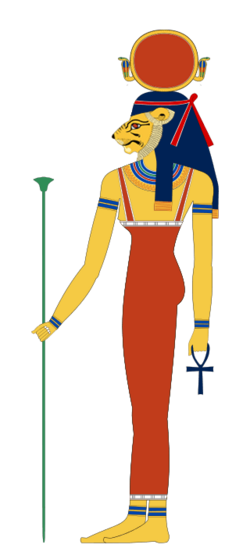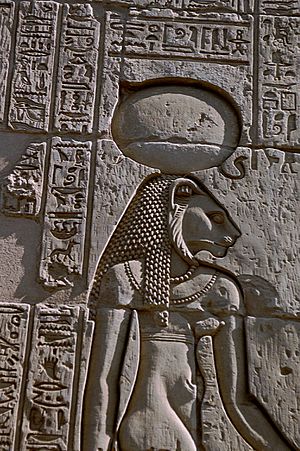Tefnut facts for kids
Quick facts for kids Tefnut |
|
|---|---|

The goddess Tefnut portrayed as a woman with the head of a lioness and a sun disc resting on her head.
|
|
| Major cult center | Heliopolis, Leontopolis |
| Symbol | Lioness, Sun disk |
| Personal information | |
| Consort | Shu, Geb |
| Offspring | Geb and Nut |
| Parents | Ra or Atum |
| Siblings | Shu, Hathor, Maat, Anhur, Sekhmet, Bastet, Mafdet, Satet |
Tefnut was an ancient Egyptian goddess. She was known as the goddess of water and fertility. Tefnut and her brother, Shu, were often said to be the first gods created. Her parents were believed to be Ra, Atum, or Amun. Tefnut was the mother of Nut (the sky) and Geb (the earth). She is often linked to the lion. In art, she is shown as a woman with the head of a lioness. She usually has a Sun disc above her head.
Contents
Who Was Tefnut?
Tefnut and her brother Shu were the first gods created by the sun god Ra. She had other names, like Tefenet or Tefnet. Her main job was to bring moisture to the world. She also helped keep things like order, time, and justice in balance.
Tefnut was very important to both the sun and the moon. She was sometimes called the "Eyes of Ra." This meant she was seen as both the left eye (the moon) and the right eye (the sun) of the powerful sun god.
What Did Tefnut Look Like?
Tefnut was often shown as a lioness. She could also appear as a woman with the head of a lioness. This was her most common look. Sometimes, she wore her father Ra's sun disk on her head.
There is a story about Tefnut leaving Ra and causing a big drought. She turned into a fierce lioness and went to Nubia. Only the wise god Thoth could convince her to come back. When she returned, everyone in Egypt was very happy.
When Tefnut was in the royal court, she wore a special crown. It was made of plants that were growing. She was sometimes pictured lying between the earth and the sky. She also helped her husband, Shu, hold up the sky goddess Nut. It was said that her tears of pain helped make the ground fertile.
Tefnut's Powers and Symbols
Tefnut had many important powers. She was the goddess of moisture, which was vital for life in ancient Egypt. She also helped decide what happened to people after they died in the underworld.
Tefnut often carried a scepter, which is a symbol of power. She also wore an ankh, which is the ancient Egyptian symbol for life. Her father's sun disk on her head showed her connection to the sun god.
Besides moisture, Tefnut was also in charge of:
She worked with her brother Shu to hold up the sky. Her main role was to bring moisture to the land for the ancient Egyptians.
Where Was Tefnut Worshipped?
Tefnut was worshipped in places where lions were important. One such place was Leontopolis, which means "City of Lions." A part of the city of Denderah was even called "The House of Tefnut."
Ancient Egyptians celebrated Tefnut on special festival days:
- August 20th: A day to make the hearts of the Ennead happy. The Ennead was a group of nine important gods.
- October 29th: A day for Het-Hert and the Ennead to go forth.
- November 15th: A feast for the Ennead in the House of Kay Heru and Wasir.
Tefnut did not have many large temples built just for her. However, she was still an important goddess in the Egyptian religion.
Images for kids
See also
 In Spanish: Tefnut para niños
In Spanish: Tefnut para niños



